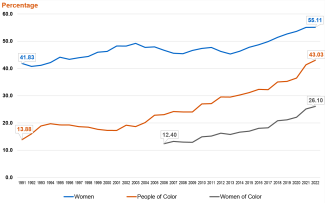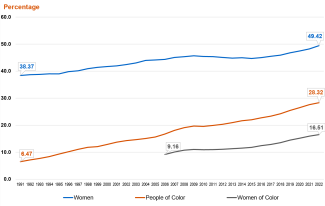NALP Report on Diversity at U.S. Law Firms – More Signs of Progress, Longer Road Ahead
In her December 20, 2022, Law|Fully post, Susan Krinsky reported that “the incoming class of 2022 is by far the most racially and ethnically diverse law school class in history.” Last month, NALP released its annual Report on Diversity at U.S. Law Firms External ink opens in new browser window , reporting that the 2022 summer associate class in U.S. law firms was also the most diverse class in history. These developments are two more important steps on the journey to building a legal system that reflects the diversity of our society, and they are not unrelated.
It is no secret that the legal profession in the United States has never reflected the true diversity of the country, and women and people of color have long been underrepresented throughout the profession. One of the most acute areas of underrepresentation has been and continues to be at private law firms. And while law schools, law firms, and the legal profession have all been working to change that, in general the progress has been slow.
Recently, however, the momentum has shifted. For the last two years running, both law schools and law firms have reported their most diverse entering classes ever. In fact, NALP reports that in 2022 the percentage of summer associates who were people of color grew to 43.03%, up from 41.34% in 2021, noting that “most of this growth can be attributed to the rise in the percentage of Black and multiracial summer associates.” In addition, women made up 55% of summer associates in 2022, the fifth year in a row that women have accounted for more than half of all summer associates. The percentage of LGBTQ+ associates of all races and ethnicities continues to grow as well, making up 9.37% of the summer associate class in 2022.
Chart 1: Percentage of Summer Associates Who are Women and People of Color at Law Firms, 1991-2022

This sort of rapid progress was not always the case. If we go back 30 years, NALP data show that in 1992, people of color made up just 16.02% of all summer associates and women made up just 40.75% of summer associates. Ten years later, in 2002, those numbers were just 19.19% and 48.22%, respectively, and by 2012, people of color made up just 29.55% of summer associates and women represented 46.26% of the summer associate class. These numbers marked positive progress over that 20-year period, but as NALP has long noted, the progress was incremental at best. By contrast, the representation of people of color among the incoming ranks of summer associates at law firms has grown dramatically in the last two years, from 36.48% in 2020, to 41.34% in 2021, and 43.03% in 2022.
George Floyd was murdered on May 25, 2020, in an act of police violence. The reverberations of that act of violence, and all the events that followed it as America reckoned with its deep history of racism, galvanized law firms and many individuals throughout the legal profession to take action in ways they never had before. NALP data show that the representation of people of color in the law firm summer associate class jumped a full five percentage points from the summer of 2020 to the summer of 2021, an unprecedented jump, the momentum of which carried into 2022 with further impressive gains. NALP’s executive director Nikia Gray notes External ink opens in new browser window that in 2022, “the percentage of summer associates and associates of color continued to increase compared to last year, with much of that growth attributed to the rise in Black summer associates and associates specifically. In the summer associate ranks, the total percentage of associates of color increased by 1.7 percentage points compared to last year, with the percentage of Black and multiracial summer associates both rising approximately 0.7 points to 11.85% and 5.48% of summer associates, respectively. In tandem with this, the representation of associates of color reached a historic high of 28.32%, with the percentage of Black associates increasing by over half a percentage point to 5.77%.”
Chart 2: Percentage of Associates Who are Women and People of Color at Law Firms, 1991-2022

Note: Starting in 2006, data collection was expanded to include gender within each racial/ethnic category; therefore, data on women of color are not available for prior years. From 1991-2005, associated figures include senior attorneys and staff attorneys.
Reprinted with permission of the National Association for Law Placement.
It is true that law firms have been motivated to change the ways they hire new lawyers by a series of tragic historical events. Their ability to move as quickly as they did, and to make such rapid change in such a short amount of time, depended on the years of work that had been done ahead of time to ensure that the graduating law school classes were rich in diversity, rich enough to support the assembly of summer associate classes as diverse as the ones that were brought in during the summers of 2021 and 2022. It’s worth noting that the growth in diversity of the entering law school cohorts has been accomplished with the LSAT; as noted, the incoming class of 2022 is by far the most racially and ethnically diverse class in history External ink opens in new browser window , and 98% of those matriculants used the LSAT as part of their applications. Careful, deliberate admission practices, and the careful, thoughtful use of the LSAT as one of the best predictors of law school success, have allowed law schools to assemble entering 1L classes that are producing graduates of the caliber and breadth necessary to allow law firms to make the recent progress that they have.
This progress is welcome, but the hard work is by no means done. We need to continue to increase the proportion of students of color entering law school, but that alone is not enough. We need to continue to increase the proportion of summer associates and first-year associates of color, but that alone is not enough. We need to take a comprehensive approach at every step of the journey from prelaw through law school through practice, and ensure we are creating and maintaining an environment in which every student and every attorney can flourish.
As NALP’s recent report points out, women and people of color continue to be dramatically underrepresented at the partnership level in law firms. According to NALP, “in 2022, people of color accounted for only 11.40% of all partners (equity and non-equity), while women comprised only 26.65%.” Women of color have fared the worst of all, as NALP notes: “Despite small gains in 2022, just over 4% of all partners are women of color, and Black women and Latinas each continued to represent less than 1% of all partners in U.S. law firms.”
So, even as we welcome the recent progress at two key entry spots into the profession, the first-year entering class at law school and the first-year entering class at law firms, it is more important than ever to double down on programs and initiatives at every stage of the prelaw to practice pathway.
As Susan Krinsky noted in her December 2022 post, “we still have a long way to go to create a legal profession that reflects the diversity of society and provides full access to justice for everyone.”

